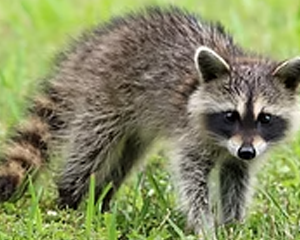Raccoon - Commonly Trapped Furbearer
UTILIZING OUR ABUNDANT MISSOURI WILDLIFE

Raccoon
Fast Facts
- Length: ~24–38 inches (incl. 7–10 inch tail)
- Weight: ~12–30 pounds (season & food dependent)
- Teeth: 40
- Mating Season: Jan–Feb (peak winter)
- Litter Size: 3–5 kits (born spring)
- Activity: Mostly nocturnal; dens in trees/structures
- Diet: Omnivore—grains, fruits, invertebrates, small vertebrates
- Life Span: typically <5 years in wild
Raccoons are adaptable omnivores recognized by their black facial “mask” and ringed tail. They thrive in farms, towns, and wildlands, and are among the most frequently encountered furbearers around people. Dexterous forepaws allow them to manipulate latches, open containers, and probe for food in water or crevices.
Description
Stocky, gray-brown fur with a grizzled appearance; pointed muzzle; rounded ears with pale edges. The tail is bushy with alternating dark and light rings. Forepaws are hand-like with prominent, tapered digits; hind feet longer with a plantigrade stance. Adult size and mass vary widely with habitat quality and season, often peaking in late fall.
Reproduction
Breeding usually occurs in mid-winter. After a gestation of roughly two months, females whelp in spring (often March–April). Typical litters are 3–5 kits. Young remain in the den several weeks, then accompany the female on nocturnal foraging trips before dispersing later in the year. Females raise the litter alone.
Habits
Primarily nocturnal, raccoons den in hollow trees, rock outcrops, ground burrows, or human structures (attics, barns). In northern areas, they may reduce activity during prolonged cold spells but do not truly hibernate. Home ranges overlap; individuals communicate with vocalizations and scent. Excellent climbers and capable swimmers.
Diet
Highly opportunistic: corn and other grains, fruits and mast, insects, crayfish, snails, frogs, small mammals and birds, eggs, and carrion. Foraging often follows riparian corridors and edges where diverse foods are concentrated.
Range
Statewide in Missouri and common across much of North America, especially in mosaic landscapes of woodlots, wetlands, and agriculture, as well as suburbs and towns.
Tracks and Sign
Tracks show five long toes on both front and hind feet; the foreprint appears hand-like. Scat varies with diet—often contains seeds or shells. Den sites may show worn entrances, scratch marks, or accumulations of droppings at base of trees or on ledges.
General / Management Notes
Conflicts arise around poultry, pet food, sweet corn, and buildings. Regulated trapping and exclusion practices (securing food sources, hardening structures) are effective tools to reduce damage while maintaining healthy populations.
Contact Missouri Trappers Association
Get in touch with the Missouri Trappers Association by filling out the contact form. We appreciate your support!
For questions regarding your membership, please call
Joslyn Search: (660)292-1911


